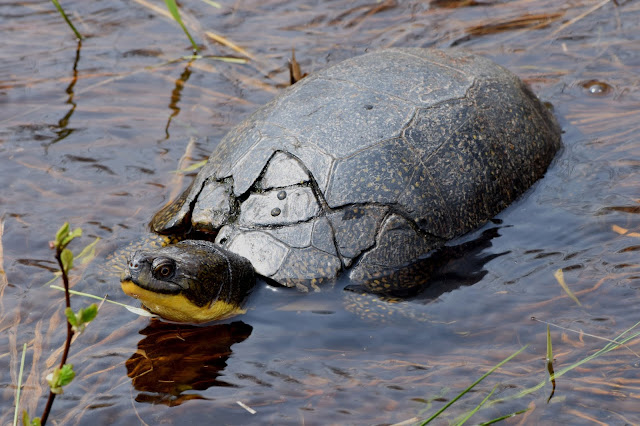I have had the pleasure of camping in one of the most magical places in Ontario, Georgian Bay Islands National Park, a few times now. I always visit in the spring when the park is coming alive. We catch a boat from the marina over to the island and camp for the May long weekend. It is always a lovely great time spent with friends and friends-to-be.
The purpose of course for this journey is a survey of reptiles and amphibians of the park. This year was the coldest weather we had ever experienced on the islands with most days being rainy and it always dropping below ten degrees Celsius at night. With the weather forecast so gloomy and cold we didn't expect much to be out moving around, but we actually had a fair amount of diversity in much lower numbers than previous years.
Eastern Hognose Snakes are one of my favorites on this trip for sure. They are often mistaken for rattlesnakes due to their brown blotchy coloration.When they are being defensive they may flatten their heads and body, display like a cobra or play dead by flipping themselves over and musking. Their prominent upturned "pig" nose is used as a shovel to dig up their favorite food, toads. Maybe it is the toad diet but these guys can really stink when they musk.
 |
| Eastern Hognose Snake (Heterodon platirhinos) |
 |
| Eastern Hognose (Heterodon platirhinos) |
Massasauga Rattlesnakes are fairly common on the islands. This snake is venomous but rarely bites people. Watch where you step and leave them be. They are usually coiled up and will rattle as a warning if they notice you getting to close to them. These snakes are beautiful
 |
| Massasauga Rattlesnake (Sistrurus catenatus) |
Ring-necked Snakes are small snakes that rarely ever bite but do musk. When disturbed they usually coil up and hide their head. They always look glossy smooth.
 |
| Ringneck Snake (Diadophis punctatus) |
Northern Watersnakes are completely harmless snakes but can also have a brown blotchy pattern that gets them mixed up with Rattlesnakes. I was lucky enough to find a pair mating and a few young snakes. From the pair mating in the photo below the female is the larger snake and the male is the smaller snake on top of her.
 |
| Northern Watersnake (Nerodia sipedon) |
When young watersnakes have more of a pattern and these freshly shed young ones were so tiny and beautiful.
 |
| Northern Watersnake (Nerodia sipedon) |
Eastern Ribbonsnakes are a long slender snake with patterning similar to an Eastern Gartersnake. Eastern Ribbonsnakes have a distinctive white crescent in front of their eye. These snakes are fast moving and on a warm day it's very hard to get a decent photo of them. But with the weather fairly cold this particular weekend I was able to get the nicest photos I have ever taken of a Ribbonsnake!
 |
| Eastern Ribbonsnake (Thamnophis sauritus sauritus) |
 |
| Eastern Ribbonsnake (Thamnophis sauritus sauritus) |
 |
| Eastern Ribbonsnake (Thamnophis sauritus sauritus) |
Most species of Ontario turtles can be found on the islands Northern Map Turtles are frequent on the rocky shores around the islands. Painted Turtles are common across Ontario, but the joy of seeing them for the first time in a year never gets old.
 |
| Painted Turtle (Chrysemys picta) |
It is very hard to pick a favorite turtle but these two are definitely both in the running. Stinkpot Turtles are small turtles with a large head with yellow stripes. Their shells are brown-olive green on top and they have a plastron that doesn't fully cover their stomach. This allows them to walk easily on the bottom of lakes and ponds. They are more active at night and at night or early morning are some of the easiest times to find them. You'll still probably have to get wet looking though. Despite the cold weather I was waist deep in water looking for them hiding under floating vegetation.
 |
| Stinkpot Turtle (Sternotherus odoratus) |
 |
| Stinkpot Turtle (Sternotherus odoratus) |
Blanding's Turtles are pretty much everyone's favorite turtle. It's really hard to dislike this cheery looking charismatic turtle. The bright yellow chin makes it look like it's always smiling at you. Sadly this species is also at risk and some of the threats include cars and boats running them over. The one below was lucky enough to survive one a collision.
 |
| Blanding's Turtle (Emydoidea blandingii) |
 |
| Blanding's Turtle (Emydoidea blandingii) |
A lot of amphibians were starting to move on the rainy nights and the days were filled with calls of breeding American Toads. The most common amphibian we saw was Redback Salamanders. These small salamanders were out in mass on the rainy nights crawling over mossy and rocky surfaces.
 |
| Redback Salamander (Plethodon cinereus) |
Redback Salamanders also have a "Leadback" colour variation that lacks the red-orange stripe.
 |
| Redback Salamander (Plethodon cinereus) |
The habitats on the islands are variable form rocky shorelines, deciduous forests to wetlands. This diversity of habitats brings out a variety of spring flora including Rock Harlequin, White Bog Violet, Virginia Saxifrage, Easrly Meadowrue, Yellow Trout Lily, Sharp-lobed Hepatica, Round-lobed Hepatica, Starflowered Lily-of-the-Valley, Jack in the Pulpit, Haiy Solomon's Seal, Downy Yellow Violet, Blue Cohosh, Two-leaf Toothcup, Largeflower Bellwort and Trilliums.
 |
| White Bog Violet (Viola lanceolata) |
 |
| Virginia Saxifrage (Micranthes virginiensis) |


















No comments:
Post a Comment